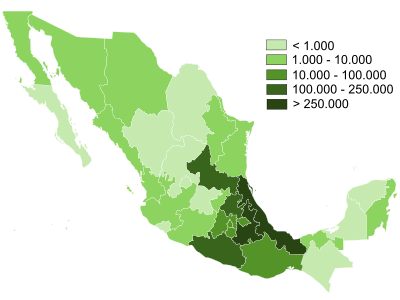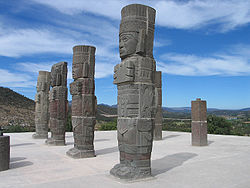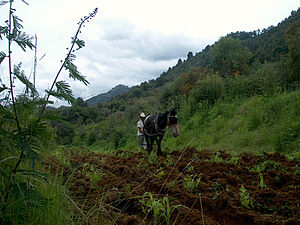- Nahua peoples
-
Nahua Total population 2,500,000 Regions with significant populations Mexico
Oaxaca, Morelos, Puebla, Hidalgo, Michoacán, Veracruz, Jalisco, Estado de México, Distrito Federal, Tlaxcala, Durango and GuerreroLanguages Nahuatl and Spanish
Religion Christianity (Predominantly Roman Catholic), traditional religion is still practiced also.
Related ethnic groups Indigenous people of the Americas
The Nahuas are a group of indigenous peoples of Mexico. Their language of Uto-Aztecan affiliation is called Nahuatl and consists of many more dialects and variants, a number of which are mutually unintelligible. About 1,500,000 Nahua speak Nahuatl and another 1,000,000 speak only Spanish.
Evidence suggests the Nahua peoples originated in the southwestern part of what is now the United States and northwestern Mexico. They split off from the other Uto-Aztecan speaking peoples and migrated into central Mexico around 500 CE. They settled in and around the Basin of Mexico and spread out to become the dominant people in central Mexico. Some of the most important Mesoamerican civilizations were of Nahua ethnicity, including the Toltec and Aztec cultures, as well as the Tepaneca, Acolhua, Tlaxcaltec, Xochimilca, and many others.
Contents
Nomenclature
The name Nahua is derived from the Nahuatl word nāhuatl, which means "clear", "intelligible" or "speaking the Nahuatl language". It was used in contrast with popoloca, "to speak unintelligibly" or "speak a foreign language". Another, related term is Nahuatlaca, literally "Nahua people".
The Nahuas are also sometimes referred to as Aztecs. Using this term for the Nahuas has generally fallen out of favor in scholarship, though it is still used for the Aztec Empire. They have also been called Mexicanos or Mexicans, after the Mexica, a prominent Nahua group.
Geography
At the turn of the 16th century, Nahua populations occupied territories ranging across modern-day Mexico, Guatemala, El Salvador and Nicaragua as far south as Panama.[1] These were gradually assimilated into mestizo society in most places. The last of the southern Nahua populations are the Pipil of El Salvador.
Nahua populations in Mexico are centered in the middle of the country, with most speakers in the states of Puebla, Veracruz Hidalgo, Guerrero and San Luis Potosí. But smaller populations are spread throughout the country, following recent population movements within Mexico. Within the last 50 years, Nahua populations have appeared in the USA, particularly in New York and L.A.[2]
History
Pre-columbian period
Archaeological, historical and linguistic evidence suggest that the Nahuas originally came from the deserts of northern Mexico and the southwestern U.S. and migrated into central Mexico in several waves.[3] Before the Nahuas entered Mesoamerica they were probably living for a while in northwestern Mexico alongside the Cora and Huichol peoples.[4] The first group of Nahuas to split from the main group were the Pochutec who went on to settle on the Pacific coast of Oaxaca possibly as early as 400 CE[5] From ca 600 CE the Nahua quickly rose to power in central Mexico and expanded into areas earlier occupied by Oto-Manguean, Totonacan and Huastec peoples.[6]
Around 1000 CE the Toltec people, normally assumed to have been of Nahua ethnicity, established dominion over much of central Mexico which they ruled from Tollan Xicocotitlan.[7]
From this period on the Nahua were the dominant ethnic group in the Valley of Mexico and far beyond, and migrations kept coming in from the north. After the fall of Toltecs a period of large population movements followed and some Nahua groups such as the Pipil-Nicarao arrived as far south as Nicaragua. And in central Mexico different Nahua groups based in their different "Altepetl" citystates fought for political dominance. The Xochimilca, based in Xochimilco ruled an area south of the lake Texcoco; the Tepanecs ruled the area to the west and the Acolhua ruled an area to the east of the valley. One of the last of the Nahua migrations to arrive in the valley settled on an island in the Lake Texcoco and proceeded to subjugate the surrounding tribes. This group were the Mexica who during the next 300 years became the dominant ethnic group of Mesoamerica ruling from Tenochtitlan their island capital. Allying with the Tepanecs and Acolhua people of Texcoco they formed the Aztec empire spreading the political and linguistic influence of the Nahuas well into Central America.
Conquest period (1519–1523)
Main article: Spanish conquest of MexicoIn 1519 an expedition of Spaniards sailing from Cuba under the leadership of Hernán Cortés arrived on the Mexican gulf coast near the Totonac city of Quiyahuiztlan. The Totonacs were one of the peoples that were politically subjugated by the Aztecs and word was immediately sent to the Aztec Tlatoani of Tenochtitlan Motecuhzoma II. Going inland the Spaniards encountered and fought with Totonac forces and Nahua forces from the independent Altepetl of Tlaxcallan. The Tlaxcaltecs were a Nahua group who had avoided being subjugated by the Aztecs. After being defeated in battle by the Spaniards, the Tlaxcalans entered into an alliance with Cortes that would be invaluable in the struggle against the Aztecs.[8] The Spanish and Tlaxcaltec forces marched upon several cities that were under Aztec dominion and "liberated" them, before they arrived in the Aztec capital of Tenochtitlan. There they were welcomed as guests by Motecuhzoma II, but after a while they took the ruler prisoner. When the Aztec nobility realized that their ruler had been turned into a Spanish puppet they attacked the Spaniards and chased them out of the city. The Spaniards sought refuge in Tlaxcala where they regrouped and awaited reinforcements. During the next year they cooperated with large Tlaxcaltec armies and undertook a siege campaign resulting in the final fall of Tenochtitlan. After the fall of Tenochtitlan Spanish forces now also allied with the Aztecs to incorporate all the previous Aztec provinces into the realm of New Spain. New Spain was founded as a state under Spanish rule but where Nahua people were recognized as allies of the rulers and as such were granted privileges and a degree of independence that other indigenous peoples of the area did not enjoy. Recently historians like Matthew Restall have argued that the Nahua did not experience the conquest as something substantially different from the sort of ethnic conflicts that they were used to, and that in fact they may have at first interpreted it as a defeat of one Nahua group by another.[9]
Colonial Period
With the arrival of the Spanish in Mesoamerica a new political situation ensued. Historian James Lockhart has divided the colonial history of the Nahua into three stages according to the degree of interaction between Spaniards and Nahuas and the following changes in Nahua culture.[10]
Stage one (1519 - ca. 1550)
In the initial stage of the colonial period, contact between Spaniards and the indigenous populations was limited. It consisted mostly in the Christianization of the population, and the reorganisation of the indigenous tributary system. The indigenous system of smaller villages' paying tribute to dominant political entities was worked into the Encomienda system. Indigenous groups paid tribute to a Spanish encomendero {landholder}. As the Spaniards sought to extend their political dominance into the most remote corners of Mesoamerica, the Nahua accompanied them as footsoldiers. In the early colonial period, new Nahua settlements were made in northern Mexico and far south into Central America. Nahua forces often formed the bulk of the Spanish military expeditions that conquered other Mesoamerican peoples, such as the Maya, Zapotecs and Mixtecs.
With the arrival of Christian missionaries, the first priority of the colonial authorities was eradicating indigenous religious practices, something they achieved by a combination of violence and threats of violence, and patient education. Nahua were baptized with Spanish names. The few Nahua who did not willingly abandon their religious practices were severely punished or executed. The Nahua, however, often incorporated pre-Christian practices and beliefs into the Christian religion without the authorities' noticing it. Often they kept practicing their own religion in the privacy of their homes, especially in rural areas where Spanish presence was almost completely lacking and the conversion process was slow.
The Nahua quickly took the Latin alphabetic writing as their own. Within 20 years of the arrival of the Spanish, the Nahua were composing texts in their own language. In 1536 the first university of the Americas, the Colegio de Santa Cruz de Tlatelolco was inaugurated. It served to educate the indigenous Nahua nobility as priests who were trilingual: speaking Spanish, Latin and Nahuatl.[11]
Stage two (ca. 1550 - ca. 1650)
Stage three (ca. 1650 - 1821)
Modern (Postcolonial) Period
Demography
Speakers over 5 years of age in the ten states with most speakers (2000 census). Absolute and relative numbers.[12] Region Totals Percentages Federal District 37,450 0.44% Guerrero 136,681 4.44% Hidalgo 221,684 9.92% Mexico (state) 55,802 0.43% Morelos 18,656 1.20% Oaxaca 10,979 0.32% Puebla 416,968 8.21% San Luis Potosí 138,523 6.02% Tlaxcala 23,737 2.47% Veracruz 338,324 4.90% Rest of Mexico 50,132 0.10% Total: 1,448,937 1.49% The Mexican government does not categorize its citizens by ethnicity, but only by language. Statistical information recorded about the Nahua deals only with speakers of the Nahuatl language, although unknown numbers of people of Nahua ethnicity have abandoned the language and now speak only Spanish.
Across Mexico, Nahuatl is spoken by an estimated 1.4 million people, including some 190,000 who are monolingual.[13] The state of Guerrero has the highest ratio of monolingual Nahuatl speakers, calculated at 24.8%, based on 2000 census figures. The proportion of monolinguals for most other states is less than 5%.[14]
The largest concentrations of Nahuatl speakers are found in the states of Puebla, Veracruz, Hidalgo, San Luis Potosí, and Guerrero. Significant populations are also found in México State, Morelos, and the Mexican Federal District, with smaller communities in Michoacán and Durango. Nahuatl was formerly spoken in the states of Jalisco and Colima, where it became extinct during the 20th century. As a result of internal migrations within the country, all Mexican states today have some isolated pockets and groups of Nahuatl speakers. The modern influx of Mexican workers and families into the United States has resulted in the establishment of a few small Nahuatl-speaking communities, particularly in New York and California.[15]
64.3% of Nahuatl speakers are literate in Nahuatl compared with the national average of 97.5% for Spanish literacy. Male Nahuatl speakers have 9.8 years of education on average and women 10.1, compared with the 13.6 and 14.1 years that are the national averages for men and women, respectively.[16]
Culture
Language
Religion
Notes
- ^ Fowler (1985, p.38).
- ^ Flores Farfán (2002, p.229).
- ^ Canger (1980, p.12)
- ^ Kaufman (2001, p.12).
- ^ Suárez (1983, p.149).
- ^ Kaufman (2001).
- ^ Porter Weaver. 1993. pp. 388-412
- ^ Account of Bernal Diaz from Victors and Vanquished: Spanish and Nahua Views of the Conquest of Mexico. edited by Stuart Schwartz (Boston: Bedford/ St. Martin's, 2000).
- ^ Restall, 2003
- ^ Lockhart, 1991, pp.12-20
- ^ Mathes, Michael, 1985, The Americas' first academic library Santa Cruz de Tlatelolco, Sacramento" California State Library.
- ^ Source: INEGI (2000). Percentages given are in comparison to the total population of the corresponding state.
- ^ Perfil Sociodemografica de la Populacion Hablante de Nahuatl - INEGI (2000), p.43
- ^ Put another way, more than 95% of the Nahuatl-speaking population also speak at least one other language, most usually Spanish. See corresponding tables in INEGI (2000), p. 43.
- ^ Flores Farfán (2002), p. 229
- ^ Perfil Sociodemografica de la Populacion Hablante de Nahuatl - INEGI.
References
-
- Canger, Una (1980). Five Studies Inspired by Náhuatl Verbs in -oa. Travaux du Cercle Linguistique de Copenhague, Vol. XIX. Copenhagen: The Linguistic Circle of Copenhagen; distributed by C.A. Reitzels Boghandel. ISBN 87-7421-254-0. OCLC 7276374.
- Canger, Una (1988). "Nahuatl dialectology: A survey and some suggestions". International Journal of American Linguistics (Chicago: University of Chicago Press) 54 (1): pp.28–72. doi:10.1086/466074. ISSN 0020-7071.
- Flores Farfán, José Antonio (2002). "The Use of Multimedia and the Arts in Language Revitalization, Maintenance, and Development: The Case of the Balsas Nahuas of Guerrero, Mexico". In Barbara Jane Burnaby and John Allan Reyhner (eds.) (PDF). Indigenous Languages across the Community. Proceedings of the Annual Conference on Stabilizing Indigenous Languages (7th, Toronto, Ontario, Canada, May 11–14, 2000). Flagstaff, AZ: Center for Excellence in Education, Northern Arizona University. pp. 225–236. ISBN 0-9670554-2-3. OCLC 95062129. http://jan.ucc.nau.edu/~jar/ILAC/ILAC_24.pdf.
- Friedlander, Judith (1975). Being Indian in Hueyapan: A Study of Forced Identity in Contemporary Mexico. New York: Saint Martin's Press.
- Fowler, William R., Jr. (1985). "Ethnohistoric Sources on the Pipil Nicarao: A Critical Analysis". Ethnohistory (Durham, NC: Duke University Press and the American Society for Ethnohistory) 32 (1): pp.37–62. doi:10.2307/482092. ISSN 0014-1801. JSTOR 482092. OCLC 62217753.
- Hill, Jane H.; and Kenneth C. Hill (1986). Speaking Mexicano: Dynamics of Syncretic Language in Central Mexico. Tucson, AZ: University of Arizona Press. ISBN 0-816-50898-4. OCLC 13126530.
- Kaufman, Terrence (2001) (PDF). The history of the Nawa language group from the earliest times to the sixteenth century: some initial results (Revised ed.). Project for the Documentation of the Languages of Mesoamerica. http://www.albany.edu/anthro/maldp/Nawa.pdf. Retrieved 2007-10-07.
- Lockhart, James (1996). The Nahuas After the Conquest: A Social and Cultural History of the Indians of Central Mexico, Sixteenth Through Eighteenth Centuries. Stanford, CA: Stanford University Press. ISBN 0-8047-2317-6. OCLC 24283718.
- Restall, Matthew (2003). Seven Myths of the Spanish Conquest. Oxford and New York: Oxford University Press. ISBN 0-19-516077-0. OCLC 51022823.
- Sahagún, Bernardino de (1950–82) [ca. 1540–85]. Florentine Codex: General History of the Things of New Spain. vols. I-XII. Charles E. Dibble and Arthur J.O. Anderson (eds., trans., notes and illus.) (translation of Historia General de las Cosas de la Nueva España, 13 vols. in 12 hbk. ed.). Santa Fe, NM and Salt Lake City: School of American Research and the University of Utah Press. ISBN 0-87480-082-X. OCLC 276351.
- Suárez, Jorge A. (1983). The Mesoamerian Indian Languages. Cambridge Languages Surveys series. London: Cambridge University Press. ISBN 0-521-22834-4.
- Weaver, Muriel Porter (1993). The Aztecs, Maya, and Their Predecessors: Archaeology of Mesoamerica (3rd ed.). San Diego, CA: Academic Press. ISBN 0-01-263999-0.
Categories:- Indigenous peoples in Mexico
- Mesoamerican cultures
- Nahuatl words and phrases
Wikimedia Foundation. 2010.



